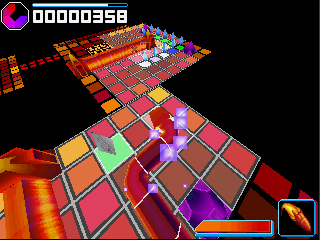
Sponge Bob Truth or Square for the PSP. Please see the game called Incoming!!
Updated: Wednesday, 18 November 2009 1:07 PM CST
Post Comment | Permalink | Share This Post

Sponge Bob Truth or Square for the PSP. Please see the game called Incoming!!

Snakes Subsonic is out for the N-Gage. I did the state machine for all the menus and HUD. I also participated in some engine level integration.







This is a spatial partitioning method known as an Octant Tree. The static geometry of the level is split into octants. When testing for collisions between geometry, we can exclude everything that is not in the current octant. Here the collision is a mouse picking scheme where a picked triangle is highlighted white.
Honk three times if you know what Honey Bucket is.

Shadow volumes was one of my favorite homework assignments. My algorithm for generating the shadow volume is loosely based on the stencil demo that comes with DirectX 8. However, the Microsoft demo generates the volume every frame and uses an algorithm that is O(n^2). YIKES! My algorithm does a lot of the generation upon level load. I use the adjacency matrix that is exposed by DirectX's mesh to find lit and unlit faces. The result is a really fast stencil buffer shadow volume that is easily applied to any complex mesh.

The new X-Men (that's me on the left)
Evidently, I'm "a pale, clean-cut Texan". Maybe I need to get out more.
Here's some other links you might find me mentioned:
The Z-Buffer
Z Buffer interview
Microsoft
Managed DirectX Case Study
Newer | Latest | Older